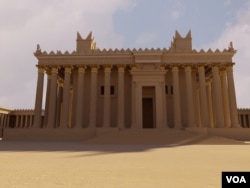Web developer and open source activist Bassel Khartabil is being held in an undisclosed location by the Syrian government. But while behind bars, his images and digital recreations of Palmyra, the historic city recently seized by the Islamic State (IS) group, are finding life on one of the Internet's largest open source platforms.
His supporters hope Palmyra and Khartabil, both caught in Syria’s civil war, might have a chance at survival thanks to new technologies used in their New Palmyra Project.
Syria's government arrested the 34-year-old Web developer and activist in March, 2012, the first anniversary of a popular uprising against President Bashar al-Assad. He was held without charge in Adra prison but disappeared from records October 3, 2015.
Syrian authorities offered no explanation and have not provided Khartabil’s current location.
Khartabil is the co-founder of the Aiki Lab in Damascus, a technology space that fostered open source programming and digital freedom.
Internationally, he has been recognized for his work with Mozilla Firefox, Wikipedia, Openclipart, and Fabrizatorz. He was also the lead for Creative Commons Syria, where his contributions "inspired collaboration, community, and the sharing of culture and knowledge,” according to Ryan Merkley, Creative Commons CEO.
In the dark
Being cut off from the world is a nightmare for anyone, but for a man whose career was based on open communication, the darkness is compounded.
“I don’t understand how he managed to be without a computer for that long," says Dana Trometer, a filmmaker and friend of Khartabil.
Part of the #FreeBasell Campaign, Trometer says Khartabil was an active member of the open source community long before the 5-year-old civil war in Syria started.
“Bassel was advocating for open Internet, open culture," said Barry Threw, New Palmyra Interim Director, adding that the project is waiting for Karthabil's return to continue directing the initiative. "Through the Aiki Lab space, he was doing a lot of education and workshops, programs to introduce Syrians, young people, to new technologies, new ways of expressing their thoughts on the Internet.”
Virtual rebuff of IS devastation
Khartabil's disappearance from the Syrian prison coincides with the online appearance of the first batch of files from the New Palmyra project, a series of 3-D models based on Khartabil’s photographs.
Starting in 2005, Khartabil walked through Palmyra taking pictures of “one of the most important cultural centers of the ancient world,” as UNESCO describes it. His aim was to document and digitally share Palmyra's treasures online.
Ten years later, in May of 2015, militants of the self-proclaimed caliphate that spans the Syria-Iraq border are the ones walking Palmyra's streets.
IS has targeted the monuments, including Palmyra’s Temple of Bell and the Arch of Triumph, destroying them in an attempt to purge anything the extremists define as "un-Islamic."
Not that Khartabil could have foreseen how soon his work would prove valuable, Trometer argues. “He didn’t think this will be happening. He was just preserving Palmyra.”
Considering the lack of information in prison, she adds, he “might not even know IS is destroying Palmyra."
Crowdsourcing history
“Due to the destruction in Palmyra, in Syrian culture, and the deletion of some of the cultural heritage that has been there,” the New Palmyra Project “seeks to build community and create a positive political gesture. It’s about taking the old things that were there and building on top of them to create a new Palmyra in the virtual space,” Threw tells VOA.
The project published its files with a Creative Commons license, which allows anyone to use them. They can be used by computer artists and software engineers to create animations, Web interactives, virtual tours, and 3D printings.
Palmyra’s treasures could now have a new life in the online world.
"These images will help both for instruction as well as any conservation activity,” says Aparna Tandon, who leads the disaster risk management program at the International Center for the Study of the Preservation and Restoration of Cultural Property, based in Italy.
Threw says the New Palmyra project is a mix of both Palmyra’s new digital folklore and virtual echoes of its vanishing real-world assets.
“We are much more than a science project or straight visual archeology project," Threw says. "We are more of a community building, a creative artistic project, focused on creating something new. We are drawing of this data, these 3-D models, but using them to build something that was not there before, rather than just archiving the past.”
These new narratives embrace performing arts: upcoming events in Paris, San Francisco and Dubai include dance and hacking events.
While networking technology is giving new life to Palmyra, Khartabil's supporters are hoping the digital spotlight will help win his release.


